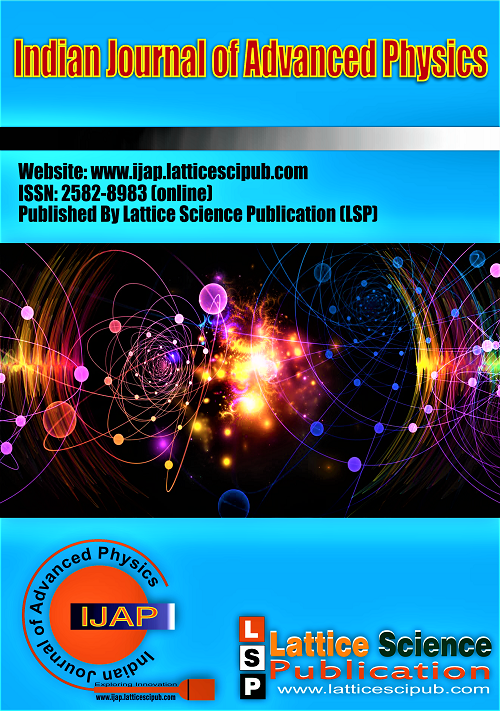Space Physics of the Universe and the Evolution of π Space Quantum
Main Article Content
Abstract
The mathematical constant π, defined as the ratio of a circle's circumference to its diameter, has remained an important base of mathematics and science, yet its origins and connections to fundamental universal properties remain elusive. Traditionally viewed through a mathematical lens, this study proposes a novel perspective, linking π to the space-time of the universe. Building on Lord Kelvin's mathematical formulation involving the square root of π, we explore its physical significance as a measure of the interplay between surface and bulk properties of matter in the cosmos. We demonstrate that π governs critical relationships in spatial pressure dynamics, linking "direct space," "inverse space," and "hybridised space" in equilibrium. Furthermore, π is shown to underlie the transition between bulk and surface phenomena, influencing fundamental processes such as harmonic motion. These findings suggest that π is not merely a mathematical abstraction but a universal parameter deeply embedded in the structure and dynamics of space-time. This perspective opens new avenues for understanding π in relation to the physical universe, offering insights into its non-converging nature and its role as a driving force in cosmic processes.
Downloads
Article Details

This work is licensed under a Creative Commons Attribution-NonCommercial-NoDerivatives 4.0 International License.
How to Cite
References
Bhattacharya C (2020) Novel Quantum Gravity interpretation of Chemical Equilibrium, Free Energy, Dark Energy and Dark Matter of the Universe. Advances in Theoretical & computational physics 3(3): 86-95. DOI: https://dx.doi.org/10.33140/ATCP
Bhattacharya C (2020) Novel Quantum Gravity Approach to Evaluate The Dimensionalities and the Geometrical Profiles of the Chemical Reactions. International Journal of Scientific & Engineering Research 11 (4):373-391. https://www.ijser.org/researchpaper/NOVEL-QUANTUM-GRAVITY-APPROACH-TO-EVALUATE-THE-DIMENSIONALITIES-AND-THE-GEOMETRICAL-PROFILES-OF-THE-CHEMICAL-REACTIONS.pdf
Bhattacharya C (2020) Cosmology and Unified Quantum Gravity Theory of the Universe. Advances in Theoretical & Computational Physics. 3(3): 114-211. DOI: https://dx.doi.org/10.33140/ATCP
Bhattacharya C (2020) Unified Quantum Gravity Theory Driven Concepts of the Classical Laws of Physics, the Dark Energy, the General Theory of Relativity and the ‘Zero-Energy Universe’. Advances in Theoretical & Computational Physics 3(4): 265-286. DOI: https://dx.doi.org/10.33140/ATCP
Bhattacharya C (2021) Novel Quantum Gravity Model of the Physics of Operability of Galvanic Cells and Electrical Power Generation. Advances in Theoretical & Computational Physics 4(1): 7-13. DOI: https://dx.doi.org/10.33140/ATCP
Bhattacharya C (2023) TTQG (Topological Theory of Quantum Gravity) Driven New Theory of colour Physics. Advances in Theoretical & Computational Physics 6(1): 1-9. DOI: https://dx.doi.org/10.33140/ATCP
Bhattacharya C (2023) Reformulating the Basics of Conventional Newtonian Physics, Quantum Physics and the Einstein Theories of Relativities Based on the newly discovered Topological Theory of Quantum Gravity (TTQG). Physical Science and Biophysics J 7(1): 1-23. https://medwinpublishers.com/PSBJ/reformulating-the-basics-of-conventional-newtonian-physics-quantum-physics-and-the-einstein-theories-of-relativities-based-on-the-newly-discovered-topological-theory-of-quantum-gravity-ttqg.pdf
Bhattacharya C (2023) The Newly Discovered Topological Theory of Quantum Gravity (TTQG) - a Multi block Compatibilizer Cum Modifier of the Existing Theories of Physics, Cosmology, Quantum Mechanics and Quantum Computing. Global Journal of Science Frontier Research 23(a4): 13-58. https://journalofscience.org/index.php/GJSFR/article/view/102674
Bhattacharya C (2024) Theory of Space Quantization and the Quantum Level Understanding of the True Logics of the Principles of Thermodynamics and Heat Engines. Global Journal of Science Frontier Research: A Physics and Space Science, (LCC): QC174.17. https://globaljournals.org/GJSFR_Volume24/2-Theory-of-Space-Quantization.pdf
Bhattacharya C (2024) Theory of Space quantization (TSQ) Driven Version of the Conventional Theories of Physics, Relativity, and Gravitation - A Concise Report. Open Access Journal of Astronomy (OAJA)” Medwin Publishers, DOI: 10.23880/oaja-16000134. https://medwinpublishers.com/article-description.php?artId=13353
Bhattacharya C (2024) Embodying the Abstract ‘Time Variable’ of the Universe through Thermodynamics
and the Theory of Space Quantization (TSQ). Open Access Journal of Astronomy (OAJA), DOI: https://doi.org/10.23880/oaja-16000142.
Propp, J. (2021). The Square Root of Pi. Math Horizons, 28(3), 14–17. https://www.jstor.org/stable/48664731
Lord Kelvin, & Tait, P. G. (1902). Mathematical and physical papers (Vol. 5). Cambridge University Press. https://archive.org/details/mathematicalphys05kelvuoft
Einstein, A. (1915). The Field Equations of Gravitation. In The Collected Papers of Albert Einstein (Vol. 6, Doc. 25). Princeton University Press. https://einsteinpapers.press.princeton.edu/vol6-trans/129
Einstein Albert (1916) “The foundation of the General Theory of Relativity Annalen Der Physik 354 97:769. DOI: http://dx.doi.org/10.1002/andp.19163540702
Tandon, R. (2019). Bianchi Type V Universe and Bulk Viscous Models with Time Dependent Gravitational Constant and Cosmological Constant in General Relativity. In International Journal of Engineering and Advanced Technology (Vol. 9, Issue 1s3, pp. 251–256). DOI: https://doi.org/10.35940/ijeat.a1048.1291s319
More, R. (2024). Exploring Mathematical Models of Dark Energy: A Comprehensive Literature Review. In International Journal of Basic Sciences and Applied Computing (Vol. 10, Issue 10, pp. 1–4). DOI: https://doi.org/10.35940/ijbsac.k0522.10100624





